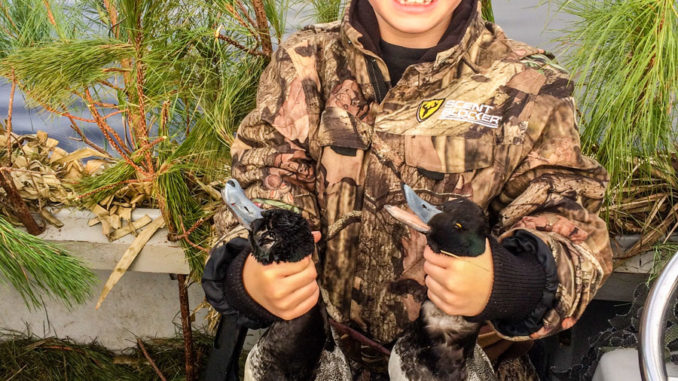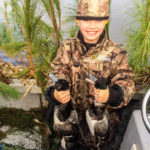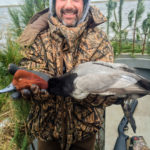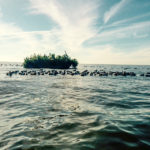
Duck season may be on the wane, but January brings North Carolina hunters some of the best big-water action of the season.
The last leg of the North Carolina’s duck season is here, promising what is likely the heaviest month of duck activity. Although many birds have already been schooled by barking shotguns, a savvy hunter can still bring them down, and there’s no better place to fill a limit with a variety of ducks than the Pamlico Sound and the southern Outer Banks.
“Usually, you will see the most ducks in January,” said guide Stewart Merritt of Morehead City, “just because it’s colder, and they’re all pushed down to where they’re going to winter. But sometimes, they don’t decoy as well because they have had some pressure.”
A waterfowler will attest to no greater feeling of helplessness than watching a raft of 400 birds sail past, just out of shotgun range. Step one to taking wary ducks is concealment. To stay hidden in plain sight, Merritt, who runs Salt Air Ventures Charters, transforms his boat into a floating island courtesy of his custom-made scissors rig.
Aptly named for the scissoring motion that allows the floating juniper frame to be unhinged from the bow and gunwales and slid into the water, this bottom layer will be laced with upright pine limbs to cloak the boat. Another board, bolted to the bow and gunwales, will also be laced with vertical limbs to camouflage the hunters.
Merritt’s next step is to use the duck’s keen eyesight to his advantage. While hunters must remain hidden, an enticing area for ducks to land must be visible. Decorating with more than 300 decoys ensures that any birds he can see can also see his spread.
“I try to put the most decoys towards the biggest area of water I feel the birds are going to come from,” said Merritt. “I’ll try to place them where it plays with their eyes. I want it to be a long spread of decoys that looks like a real raft of ducks laying on the water — as opposed to putting them in a big circle around you.
“I use more redhead and bluebill decoys. You always will see some pintails and gadwalls, so It’s good to have three or four dozen of those out. At times, you’ll see black ducks.
“Ducks will decoy to a specific decoy. That’s why I keep the species separate in their own little bunches, trying to match what I’m seeing in nature.”
Using a decoy net or raft with decoys attached at intermediate intervals, Merritt can set up more than 100 decoys as easily as paying it over the side as the boat motors forward. Both his redhead and bluebill decoys are applied in this manner due to the large numbers used and their station in the oncoming flight path. Pintails, gadwalls and black ducks are tossed off the bow and opposite gunwale, while a few buffleheads are placed on the outer perimeter.
Choosing the location for his efforts is a matter of spending time on the water and noticing the flight paths the ducks use, as well as the areas in the sound where they go to rest. Once in the vicinity, Merritt uses the topography to cut the wind and the waves while allowing the size of the spread to bring the ducks to him.
While small islands or a curve in the shoreline will serve as a windbreak, Merritt also takes advantage of what locals call “the reef.” That’s the first sandbar on the sound side of a barrier island that helps dissipate swells. He sets up inside the undulation where the water deepens, and besides sheltering him from the waves, it puts him in position to bust birds coming off the roost or returning to it.
“It seems like the general trend is that the birds will go roost up and down the banks, up and down the sound, against Portsmouth all the way up to Ocracoke,” Merrit said. “You’ve got some really big eel grass flats there, and I believe that’s where the birds like to feed and rest, spending the nights in the shallower water. Then they get up and might fly 5 to 10 miles to a place on the sound to hang out during the daytime, float around and eat.”
Although any day on the sound is subject to be stellar, the best days often meet certain criteria.
“It has a lot to do with the weather,” Merritt said. “If we’ve got some really cold weather, the birds have to eat more. If they have to eat more, they’re going to get up and move around more. They might get up and fly and then sit back down just to stay warm. It seems like if you can get 30 miles per hour of wind, that’s the magic number. The birds are going to fly all day, and you’ll have those smaller bunches that get blown out of a group of 400. They tend to decoy really well.”
DESTINATION INFORMATION
HOW TO GET THERE — Cedar Island is the closest mainland area to Portsmouth and Ocracoke islands; a public boat ramp is a tenth of a mile from the Cedar Island Ferry terminal on Driftwood Road. Cedar Island is best access via US 70 through New Bern and Morehead City to NC 12, on to Sea Level and Cedar Island.
WHEN TO GO — The third installment of North Carolina’s general duck season opened Dec. 17 and runs through Jan. 28. The entire six weeks is a great time for seeing lots of ducks.
BEST TECHNIQUES/EQUIPMENT — The mobility of a scissors rig allows hunters to switch locations to match ever-changing flight paths, however, many ducks are taken from traditional stake blinds. Hunters should position themselves between roosting areas on barrier islands and the areas on the Pamlico Sound where ducks have been frequenting. Enormous decoy spreads are essential to attracting ducks. Calling is sparse; hunters should concentrate on remaining concealed until the final moments. Most waterfowlers carry 12-gauge shotguns shooting 3- to 3½-inch shells, choked and patterned for shots of up to 60 yards. No. 3 steel shot coupled with an extended-range choke is a good starting point.
HUNTING INFO/GUIDES — Stewart Merritt, Salt Air Ventures Charters, 252-725-1725, www.moreheadcityncfishing.com. See also Guides and Charters in Classifieds.
ACCOMMODATIONS — Davis Bed and Breakfast, Davis, 252-723-0893, www.davisbandb.com; Beaufort Inn and Suites, Beaufort, 252-728-2600, www.beaufort-inn.com; Inlet Inn, Beaufort, 252-728-3600, www.inlet-inn.com.
MAPS — Capt. Segull’s Nautical Charts, 888-473-4855, www.captainsegullcharts.com; GMCO’s Chartbook of North Carolina, 888-420-6277, www.gmcomaps.com; Sealake Fishing Guides, 800-411-0185, www.thegoodspots.com.






Be the first to comment